The Passage of the Secrets, page 8
Astrology
"God is The Great Geometer" - Plato
The Circumference of the universe is Pi
 The "Mechanics" of Astrology
The "Mechanics" of Astrology
An astrological "birth chart" is a map of the solar system which is drawn for the exact time of a person's birth and shows the place in the zodiac which each planet occupied (including the Sun and the Moon) at that exact moment. The birth chart is the principle tool of astrology.
The center of a "birth chart" is the exact longitude and latitude of the place where the person was born (actually the exact "center" is the person ). In fact, the astrological "cosmology" centers around the individual! Astrology is not immediately concerned with a planet's distance from the Sun, although the mythology associated with the celestial bodies takes this into account. The astrological birth chart simply depicts the planets' immediate location within the 360 degree circle around the Sun.
An astrological chart reveals the relationships (geometric association) which exist between the Sun, Moon and planets. An astrologer sees the solar system as an extension of the individual ("as above, so below") and interprets the interaction of the planets as revealing the dynamic archetypal energies that operate within the human psyche.
The dynamic planetary energies are determined by an interpretation of "astrological aspects", in unison with the mythological attributes associated with each celestial body.
The following table compares the dates that the sun enters a sign in tropical (Ptolemaic) and sidereal (Vedic) astrological systems, and the date when it enters the astronomical constellation by the same name. The dates can vary by as much as 2 days, from year to year, depending on the cycle of leap years, and the precession of the perihelion of the Earth's orbit over many centuries.
| Sign | Symbol | Astrological Dates | Astronomical Dates (as of AD 1977 |
Elements of the zodiac | |
|---|---|---|---|---|---|
| Tropical zodiac | Sidereal zodiac | ||||
| Aries | ram, |
March 21 – April 19 | April 14 – May 14 | April 19 – May 14 | Fire |
| Taurus | bull, |
April 20 – May 20 | May 15 – June 14 | May 14 – June 21 | Earth |
| Gemini | twins, |
May 21 – June 20 | June 15 – July 16 | June 21 – July 21 | Air |
| Cancer | crab, |
June 21 – July 22 | July 17 – August 16 | July 21 – August 11 | Water |
| Leo | lion, |
July 23 – August 22 | August 17 – September 16 | August 11 – September 17 | Fire |
| Virgo | virgin, |
August 23 – September 22 | September 17 – October 17 | September 17 – October 31 | Earth |
| Libra | scale, |
September 23 – October 22 | October 18 – November 16 | October 31 – November 23 | Air |
| Scorpio | scorpion, |
October 23 – November 21 | November 17 – December 15 | November 23 – November 30 | Water |
| Ophiuchus | snake wrestler/healer | November 30 – December 17 | November 30 – December 18 | ??? | |
| Sagittarius | archer, |
November 22 – December 21 | December 16 – January 14 | December 18 – January 19 | Fire |
| Capricornus | seagoat, |
December 22– January 19 | January 15 – February 12 | January 19 – February 16 | Earth |
| Aquarius | water bearer, |
January 20 – February 18 | February 13 – March 14 | February 16 – March 12 | Air |
| Pisces | fish, |
February 19 – March 20 | March 15 – April 13 | March 12 – April 19 | Water |
Find your sign and check out the attributes associated with it.... Sun signs and you can get a free chart here... Chart Generator
We found this page - as part of the Planet X site.
Within this site is
'The Personality Of The Soul
'
which details 'The Dawn Of Mankind'
Yarbro claims mankind as we know it today became ensouled about 50 to 60
thousand years ago. This estimate is further supported by archeological data
defining the earliest known human culture, the Mousterian culture - GrN 2572, from
an excavation around the Mussolini Canal in Italy. 31 It was dated to 55,950 +/-500
BC. It is interesting to notice that around this time, the galactic center was opposite
(in right ascension) the Vernal equinox. Astrologically speaking, the galactic center
must be conjunct or opposite the Vernal equinox to support the formation of a sentient
species. Previously, the "group soul" was one of an animal and that animal (as with many
land mammals) gave birth in the spring. It was necessary to give the baby animals the
warm spring, summer and fall months to mature so they could be relatively self-sufficient
and survive.
The transition from group to individual soul came in the spring because there had to be a smooth transition between man (the animal) and man (the ensouled creature of reason). Thereafter, men were born with an indwelling soul. The formation of a sentient species is somewhat the same as the formation of an Avatar (such as the Infinite soul which is the "Essence Twin" to all humanity). A sentient species is a primitive physical manifestation of an avatar. It is basically the group spirit of an organism that is being ensouled (Homo Sapiens in our case).
Your Destiny
Each planet in our solar system has a particular influence by which certain lessons are to be learned and for which we are tested on Earth. They are;
| Position of the Sun | 1 | 2 | 3 | 4 | 5 | 6 | 7 | 8 | 9 | Afterlife Dimension | 2 | 4 | 3 | - | 7 | 1 | 8 | - | - | Name of Planet | Mercury | Venus | Earth | Mars | Jupiter | Saturn | Uranus | Neptune | Pluto | Influence | Mind | love | testing (flesh) | anger | strength | woes | psyche | mystic | subconscious |
Astrologers would use astronomical observations of the movements of the night sky for divinatory purposes. Some of these applications were founded on correspondences between practical knowledge and celestial observations (for example, the relationship between solar position and stellar positions depends on the season, which has practical implications for agriculture), whilst others have no natural source.
The familiar "star sign", or more precisely the "sun sign", under which a person is born refers to the position of the sun in the signs on the tropical ecliptic at the time of his or her birth. Because of the precession of the equinoxes over the last three thousand years or so, the signs are out of phase with the astronomical constellations for which they are named by about a month. A few modern western astrologers, in common with those of India, cast horoscopes with reference to the actual constellations, rather than the signs. This is known as Zodiacal man, attributing the various astrological signs to body parts (medical astrology).
The idea of an astrological birth sign is that the person would have some characteristics of the mythic symbolism that the ancients identified with that constellation; so, for example, a "Libra" (the scales) will be balanced and stable. Also, because the planets are all found in the zodiac, the position of the Moon or a planet in a particular sign would have an effect on the life of that person. For example: A person may be born on June 1st. This is near the center of the sign of Gemini, and so Gemini would be his sun sign. Any planets also observed near the center of Gemini, would be in "conjunction" with the sun, and said to have a particularly strong effect on the destiny and personality of the person. At the same time, other planets are in other signs of the zodiac, and their effects would be felt on the portions of a person's life "ruled" by that sign. Significance is also associated to the angular positions of planets and signs relative to each other at the moment of a birth or other significant event.
With the Christianization of Europe, angels were associated with the signs
of the zodiac to replace the traditional gods. The traditional correlations are as follows:
Angels of the zodiac
With the Christianization of Europe, angels were associated with the signs of the zodiac to replace the traditional gods. The traditional correlations are as follows:
| Sign | Angel | Malahidael | Asmodel | Ambriel | Muriel | Verchiel | Hamaliel |
|---|---|
| Uriel | Barachiel or Barbiel | Advachiel | Gabriel | |
Barachiel |
Believe it or not, the "hour" was devised by the Chaldeans (pre-Egyptians) but made popular by the Greeks (331 BC) to enable them (the Greeks) to fashion more accurate astrologic charts (hour - horo-scope - the celestial bodies that were rising at the hour of one's birth).
The Gnostic Circle
The entire Circle is seen by Norelli-Bachelet as an alchemical journey by which an individual reconnects with their original source or original nature. This journey is also referred to in the occult symbol of the Ouroborus - the snake biting its own tail. The name ouroboros (or, in Latinized form, uroborus) is Greek (????ßó???), "tail-devourer". The depiction of the serpent is believed to have been inspired by the Milky Way, as some ancient texts refer to a serpent of light residing in the heavens.
The most recent interpretation is that the figure represents the legendary physician Asclepius, who learned the secrets of life and death from one serpent bringing another some herbs which healed it (Asclepius had previously tried to kill it). In order to avoid the human race becoming immortal under Asclepius' care.
And in the symbols of the Alpha and the Omega. In the Gnostic Circle the 0 is the Alpha and the 9 is the Omega, the 0 is the snakes tail and the 9 is the snake's head. Put in scientific terms, the 0 is Energy and 9 is Matter.
Sri Aurobindo wrote in The Life Divine that just as life evolved from matter, and mind evolved in life, that a Supramental Consciousness would emerge from the Mental creation and create an entirely new order of being. In the book by the same title, "The Gnostic Circle presents students with the means to observe the Supramental Consciousness at work in the world. Norelli-Bachelet intends to give her readers a heightened view by which they can observe the process by which the Mental Consciousness becomes obsolete as the Supramental Consciousness becomes an all-integrating force in the world.
Norelli-Bachelet presents the Gnostic Circle, as a symbol of the recovery of the Sun or Unity or the return of the One, which has been lost in the Many.
Norelli-Bachelet writes, "The Gnostic Circle is the most effective method for understanding the transformation of human consciousness. It represents a vision of wholeness and has only one objective: it deals with the soul or seed of the divine in each created thing and reveals the process by which that seed is made to flower in its process of becoming."
We recommend an astrology chart to see which influence you are under presently. Free Astrology Chart This program will make a chart like the one above. You will need your exact time of birth for it to work correctly.
A person's destiny is said to be determined by whatever section or "sign" he is born under. From Babylon, Astrology passed to the empire of ancient Egypt where it mingled with the native animism and polytheism of the Nile. The pyramids were constructed with certain mathematical relationships to the stars. The Sphinx has astrological significance. It has the head of a woman, symbolizing Virgo, the virgin, and the body of a lion, symbolizing Leo. Virgo is the first sign of the zodiac, Leo the last. So the Sphinx (which incidentally means "joining" in Greek) is the meeting point of the zodiac, indicating that the Egyptian priests believed the starting point of the earth in relation to the zodiac lay in Egypt, on the banks of the Nile.
One writer says, "Astrology, which focuses on a study of the zodiac,
some say, originated in Babylon. Turn to any book on Astrology
and you will find that it was the Chaldeans (another name for
the inhabitants of Babylon) who first developed the zodiac
by dividing the sky into sections and giving meanings to
each on the basis of the stars that are found there".
However, as we have already pointed out Seth, Thoth and Enoch began it
and passed it down. In the secret books, we find Enoch who was taught the
precessions and seasons by God and the Magi who studied it
and predicted the 'birth of a child'. What we can't explain is why the Hebrews
regard Enoch with so much favor and throw this ancient science
of Astrology out. Organized religion rejected this every time
because they didn't understand it.
Sir Isaac Newton on the history of astrology and the Magi
from Newton's "Chronology"
"After the study of Astronomy was set on foot for the use of
navigation, and the Egyptians, by the heliacal risings and
settings of the stars, had determined the length of the solar
year of 365 days, and by other observations had fixed the
solstices, and formed the fixed stars into asterisms, all which
was done in the reigns of Ammon, Sesac, Orus, and Memnon,"
(about 1000 years before Christ), "it may be presumed that they
continued to observe the motions of the planets, for they called
them after the names of their gods. By the assistance of
Petosiris, a priest of Egypt, they invented astrology, grounding
it upon the aspects of the planets, and upon the qualities of
the divinities to whom they were dedicated. Astrology was
propagated thence into Chaldaea, where Zoroaster, the legislator
of the Magi, met with it." (end quote)
The "Disciples" are the Signs of the Zodiac, by Gerald Massey - Athiest?
(Note; we do not necessarilly agree with this.)..
"Moreover, it is no accident that there are 12 patriarchs
and 12 disciples, 12 being the number of the astrological signs,
or months. Indeed, like the 12 Herculean tasks and the 12
"helpers" of Horus, Jesus's 12 disciples are symbolic for the
zodiacal signs and do not depict any literal figures who played
out a drama upon the earth circa 30 C.E. The disciples can be
shown to have been an earlier deity/folkloric hero/constellation.
Peter is easily revealed to be a mythological character,
while Judas has been said to represent Scorpio, "the backbiter,"
the time of year when the sun's rays are weakening and the sun
appears to be dying. James, "brother of Jesus" and "brother
of the Lord," is equivalent to Amset, brother of Osiris and
brother of the Lord. Massey says "Taht-Matiu was the scribe
of the gods, and in Christian art Matthew is depicted as the
scribe of the gods, with an angel standing near him, to dictate
the gospel. "Even the apostle Paul is a compilation of
several characters: The Old Testament Saul, Apollonius of Tyana
and the Greek demigod Orpheus."
Massey doesn't believe in Jesus, John, Moses, Noah, Abraham, Joshua or the rest, but there are indications that the disciples each had a different zodiacal sign...and so did each of the twelve tribes which they represented.
 There were also 12 stones on the High priest's vest. Each stone
was said to contain the powers of healing. Each stone also
represented a zodiac sign. This stone was found amoung the ruins
of Herod's Temple. The lines were created over a 9 month period to
mark the angle of the sunrise at Jerusalem. The center mark would be
the equinoxes and the outer edges were the solstices.
There were also 12 stones on the High priest's vest. Each stone
was said to contain the powers of healing. Each stone also
represented a zodiac sign. This stone was found amoung the ruins
of Herod's Temple. The lines were created over a 9 month period to
mark the angle of the sunrise at Jerusalem. The center mark would be
the equinoxes and the outer edges were the solstices.
The twelve signs of the zodiac in a radical arrangement around the Sun chariot of Helios can be found in at least seven ancient synagogues in Israel, but such images were not seen in early Christian buildings, and only in three synagogues outside Israel.
The following quotation is from the "Ancient Universal
History".
"In the reign of Gushtasp, King of Persia, flourished a
celebrated astrologer, whose name was Gjamasp, surnamed Al
Hakim, or the wise. He was the brother of King Gushtasp, and his
confidant and chief minister. He is said to have predicted the
coming of the messiah." (end quote). Gjamasp is the author of a
treatise entitled "Judicia Gjamaspis", in which is contained
his judgment on the planetary conjunctions. Therein he gave
notice that Christ should appear. "In the sphere of Persia,
saith Aben Ezra, there ariseth upon the face of the sign Virgo
a beautiful maiden, she holding two ears of corn in her hand,
and a child in her arm. She bring up a child in a place which is
called Abrie [the Hebrew land] and the child's name is called
Eisi [Jesus]." (end quote)
Gjamasp, it is said, was without a peer in his
understanding of the ways of astrology and enjoyed the company
of 9 other Persian doctors of such consummate wisdom as the
whole world could not boast. What it is that these 10 Persian
wise men knew has not yet penetrated the paradigm of Western
Man.
Credit goes to Dr. John Charles Webb, on his page entitled
Mechanics
Some how this was labeled 'pagan' and evil and the traditional Bible forefathers forbid it. It because associated with 'witchcraft and sorcery' according to religious cults but is probably part of the origional 'secret science' used by magicians and high priests. They also used healing herbs, and cures made from earthly sources including marijuana. Potions and spells were concocted from such things as frog's tongue, deer penis, ect. The star science was also used as a 'watch dog', to determine events that even Noah used when building the Ark. Once again a sacred science is called evil.
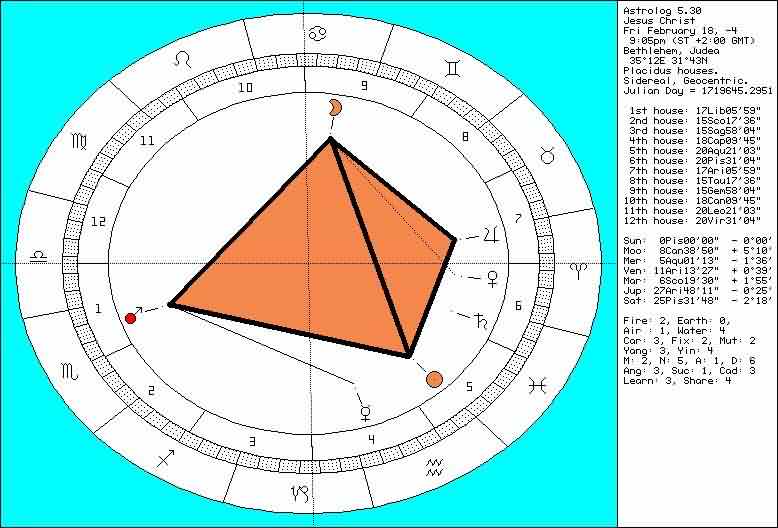 This chart is from..Chronology by John Charles Webb
It is called 'the Christ Chart'
This chart is from..Chronology by John Charles Webb
It is called 'the Christ Chart'We believe the Birth of Jesus Christ occurred in a cave at Qumran on March 17th, 7 BC. This location does not agree with the location given in the bible because the description of Bethlehem was a cave at Qumran, near the Dead Sea. That makes this chart a few degrees off the actual location of birth. Our determination of the year of birth from data below also does not agree with this chart. But we believe Jesus and the family moved to Egypt in 7BC. to escape the prosecution of Herod.
Herod's death in March 4 B.C. is an historical fact. His passing was marked by a lunar eclipse. After the visit of the Magi, Mary and Joseph took the Christ child into Egypt and remained there until they received word of Herod's death. They then returned from Egypt to Nazareth (Matthew 2:12 and 2:19-2:21). A town called Nazereth did not exist in 4 BC. That means this chart and the chart of Solomon below can not be the same, but it would give some credence to the 7BC date of Jesus' birth. The family remained in Egypt for 7 years with the Nazerine sect.
Signs in the Great Pyramid of Egypt
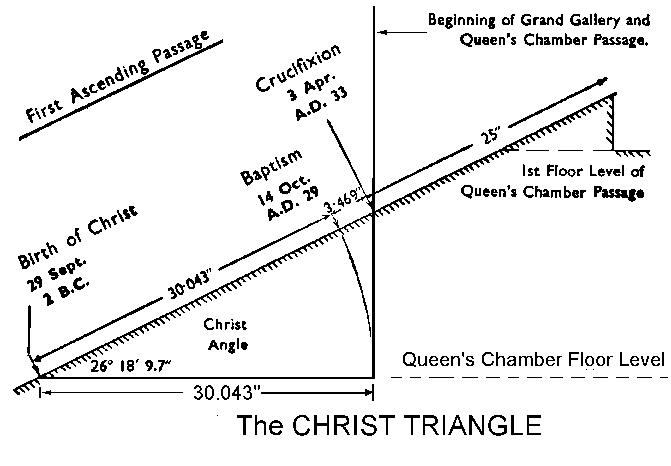 This is the Christ Triangle. It is found in the first assending
passage way from the Queen's chamber in the Great Pyramid. This
angle is also associated with ancient astrology charts which
show the same angle in a chart of Christ's birth day. It does
not have the same angle as the chart above. They interpert the
date to be Sept. 29, 2 B.C. We believe this too to be
incorrect. Our research inclines us to believe that Jesus
was born on the spring soltice of 7 BC.
This is the Christ Triangle. It is found in the first assending
passage way from the Queen's chamber in the Great Pyramid. This
angle is also associated with ancient astrology charts which
show the same angle in a chart of Christ's birth day. It does
not have the same angle as the chart above. They interpert the
date to be Sept. 29, 2 B.C. We believe this too to be
incorrect. Our research inclines us to believe that Jesus
was born on the spring soltice of 7 BC.
From SYMBOLISM AND COINCIDENCES OF THE GREAT PYRAMID
John Charles Webb Jr. uses heliocentric astrology to come up with a birth date of Feb 18th, 5 BC (9:14 AM EET, zone -2 hours) for the Jewish Messiah. Venus, Uranus and Neptune are involved in a grand trine configuration in this chart, while Earth, Moon, Pluto, Jupiter and Mercury are caught up in a second grand trine. The two grand trines together form a Star of David pattern - which is quite appropriate for a Messiah who was supposed to have been descended from David. Historically, he says this chart falls in the right time period. The Star of Bethlehem
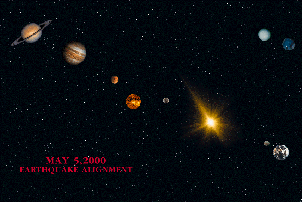 However, 7 BC was a landmark year when the planets,
Jupiter and Saturn, were "triple conjuncting" in
the sign of Pisces. Triple conjuncting means that Jupiter
and Saturn met each other in the sky three different
times in the sign of Pisces. Such a triple conjunction of
Jupiter and Saturn in the sign of Pisces is extremely rare,
and it has not occurred again during the past 2007 years.
This alignment occured again in May 2000.
However, 7 BC was a landmark year when the planets,
Jupiter and Saturn, were "triple conjuncting" in
the sign of Pisces. Triple conjuncting means that Jupiter
and Saturn met each other in the sky three different
times in the sign of Pisces. Such a triple conjunction of
Jupiter and Saturn in the sign of Pisces is extremely rare,
and it has not occurred again during the past 2007 years.
This alignment occured again in May 2000.
When author/astrologer Rick Levine explained that a conjunction of Jupiter and Saturn in 7-6 B.C. in the zodiacal sign of Pisces "created" the Star of Bethlehem, he wrote in terms of the "signature of the King's Star" (Jupiter) and "the star of final authority" (Saturn), as though these planets possessed governing providences or gods: "The greatest planetary rhythm that was observable to the ancient astronomer- priest was the rhythm of the Jupiter/Saturn conjunction... The Jupiter/Saturn conjunction...actually jumps from astrological sign to sign with great regularity... It is the combination of astrologically rare events that created the Star of Bethlehem.
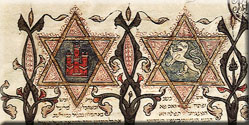 "There is much evidence to suggest that what we call the Star
of David was an alignment of the giant planets Jupiter and
Saturn. In ancient Jewish tradition, Jupiter was the planet
called the ‘King’s Star.’ Even later in Greek mythology,
Jupiter, or Jove, was the King of the Gods. Every 20 years,
when the King’s Star lined up with Saturn, the star of final
authority, the ancient Jews called this the Star of David."
"There is much evidence to suggest that what we call the Star
of David was an alignment of the giant planets Jupiter and
Saturn. In ancient Jewish tradition, Jupiter was the planet
called the ‘King’s Star.’ Even later in Greek mythology,
Jupiter, or Jove, was the King of the Gods. Every 20 years,
when the King’s Star lined up with Saturn, the star of final
authority, the ancient Jews called this the Star of David."
The Star of David is not a Jewish symbol, but an Egyptian
symbol which Israel adopted in the wilderness during the first
apostasy. (Acts 7:37-43; Amos 5:26) O.J. Graham wrote in The Six
Pointed Star: "The Universal Jewish Encyclopedia declares that
the six-pointed star...according to the Rosicrucians...was known
to the ancient Egyptians." Dr. Albert Churchward identified the
six-pointed star as the symbol of Horus in Signs & Symbols of
Primordial Man:
"In the Astro-Mythology of the Egyptians, we find belief in the
first man-god (Horus I)...and his death and resurrection as Amsu.
..This was the first sign or hieroglyphic of Amsu...Amsu - the
risen Horus - the first man-god risen in spiritual form."
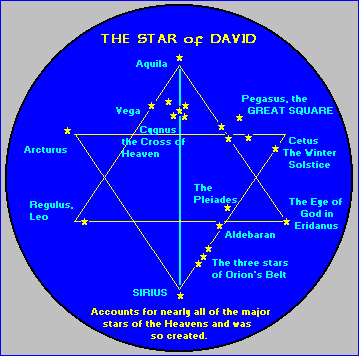 The Star of David, a six sided star or hexagram is known
among Hebrews today as Mogen David. It is also called
Solomon's Seal and consisted of two interlaced triangles.
It was originally the secret symbol
of stargazing priests, later adopted by the Isreaelite Kings David
and Solomon and subsequently by the Hebrew as a whole. As you can
see, the 'stars' did play a major role in priesthood
ceremonies and their religious beliefs. The common folks,
for the most part had no idea what the stars represented.
Each planet had a meaning that was associated with 'life'.
Venus is the star that is described as the Morning
star of rebirth, regeneration and divine knowledge. It rises just
before the morning sun sets in the east and only on the equinox
does it carry profound meaning..
The Star of David, a six sided star or hexagram is known
among Hebrews today as Mogen David. It is also called
Solomon's Seal and consisted of two interlaced triangles.
It was originally the secret symbol
of stargazing priests, later adopted by the Isreaelite Kings David
and Solomon and subsequently by the Hebrew as a whole. As you can
see, the 'stars' did play a major role in priesthood
ceremonies and their religious beliefs. The common folks,
for the most part had no idea what the stars represented.
Each planet had a meaning that was associated with 'life'.
Venus is the star that is described as the Morning
star of rebirth, regeneration and divine knowledge. It rises just
before the morning sun sets in the east and only on the equinox
does it carry profound meaning..
GRAND TRINE - three or more planets which form a triangle in which the planets are approximately 120 degrees apart. A Grand Trine indicates a supreme blessing. Michaelangelo's birth chart contained a Grand Trine.
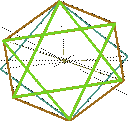 The chart here is a precise astrological map (Sun-centered or
Heliocentric) of the entire solar system for the 2nd day of
March in the year 5 BC.
The Shield of David is superimposed upon an additional ancient
configuration called a *"Grand Cross" (the light coloured square)
which offers additional support for presenting this grand
celestial display as the star which informed the Magi of the
birth of the Christ; a star which was invisible to all except
the Magi.
The chart here is a precise astrological map (Sun-centered or
Heliocentric) of the entire solar system for the 2nd day of
March in the year 5 BC.
The Shield of David is superimposed upon an additional ancient
configuration called a *"Grand Cross" (the light coloured square)
which offers additional support for presenting this grand
celestial display as the star which informed the Magi of the
birth of the Christ; a star which was invisible to all except
the Magi.
The Greek letters I CH TH U S (which begin each word of the Greek phrase) in Latin spell the word "fish". This combination helps to set the scene for the Birth of the Piscean Age of Christ (the Son/Sun) as it came forth from the "circle of animals" (the ancient zodiac). From our wonderfully enlightened friend , John Charles Webb Jr..The Sun and the twelve,"As Above, So Below"
Time, in fact, is geometry in motion because time, as we measure it, is based upon two geometric cycles (circles). The first cycle is the daily rotation of the Earth on her axis. The second cycle is the annual excursion of the Earth around the sun; a year.
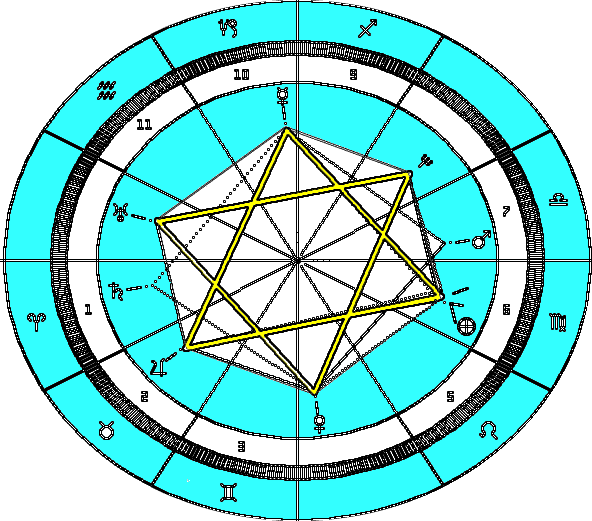 from..The Seal of Solomon
The chart is one of 1.478314266 to the 10 th power and occurs once in 40,501,760 years.
The chart also contains an an ancient astrological "Grand Cross" composed of the planets
Mercury, Venus, Saturn and Mars.
from..The Seal of Solomon
The chart is one of 1.478314266 to the 10 th power and occurs once in 40,501,760 years.
The chart also contains an an ancient astrological "Grand Cross" composed of the planets
Mercury, Venus, Saturn and Mars.
The chart is "Heliocentric" (Sun Centered) and represents the entire known solar system.
"Astrology is "a path" to wholeness, spiritual illumination and a deeper knowledge of the "Higher Self".
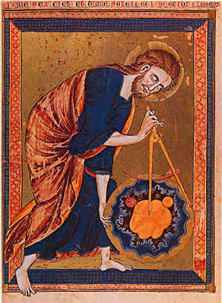 Edgar Cayce on astrology
Edgar Cayce on astrology
29. (Q) Please give a definition of the word astrology.
(A) That position in space about our own earth that is under
the control of the forces that are within the sphere of that
control, and all other spheres without that control. That is
astrology, the study of those conditions..
In the beginning, our own plane, the Earth, was set in motion. The planning of other planets began the ruling of the destiny of all matters as created, just as the division of waters was ruled and is ruled by the Moon in its path about the earth; just so as the higher creation as it begun is ruled by its action in conjunction with the planets about the earth. The strongest force used in the destiny of man is the Sun first, then the closer planets to the earth, or those that are coming to ascension at the time of the birth of the individual, BUT LET IT BE UNDERSTOOD HERE, NO ACTION OF ANY PLANET OR THE PHASES OF THE SUN, THE MOON OR ANY OF THE HEAVENLY BODIES SURPASS THE RULE OF MAN'S WILL POWER, THE power given by the Creator of man, in the beginning, when he became a living soul, with the power of choosing for himself. The inclinations of man are ruled by the planets under which he is born, for the destiny of man lies within the sphere or scope of the planets.
30.(Q) Do the planets have an effect on the life of every
individual born?
(A) They have. Just as this earth's forces were set in
motion, and about it, those forces that govern the elements,
elementary so, of the earth's sphere or plane, and as each
comes under the influence of those conditions, the influence
is to the individual without regards to the will, which is
the developing factor of man, in which such is expressed
through the breath of the Creator, and as one's plane of
existence is lived out from one sphere to another they come
under the influence of those to which it passes from time to
time.
In the various spheres, then, through which he must pass to attain that which will fit him for the conditions to enter in, and become a part of that Creator, just as an individual is a part of the creation now. In this manner we see there is the influence of the planets upon an individual, for all must come under that influence, though one may pass from one plane to another without going through all stages of the condition, for only upon the earth plane at present do we find man is flesh and blood, but upon others do we find those of his own making in the preparation of his own development.
The so-called sorcery and witchcraft may be the source of the biblical and religious rejection of astrology. But as we have discovered it does have an influence on earthly life, so we might as well understand it and use it to a better advantage.
The calendar system of ancient Egypt exactly matches this concept and is unique to both the cosmology of the Egyptians and their religion. Unlike the modern Julian calendar system, with it's 365 days to a year, the Egyptians followed a calendar system of 360 days, with three seasons, each made up of 4 months, with thirty days in each month. The seasons of the Egyptians corresponded with the cycles of the Nile, and were known as Inundation (pronounced akhet which lasted from June 21st to October 21st), Emergence (pronounced proyet which lasted from October 21st to February 21st), and Summer (pronounced shomu which lasted from February 21st to June 21st).
The beginning of the year, also called "the opening of the year", was marked by the emergence of the star Sirius, in the constellation of Canis Major. The constellation emerged roughly on June 21st., and was called "the going up of the goddess Sothis". The star was visible just before sunrise, and is still one of the brightest stars in the sky, located to the lower left of Orion and taking the form of the dogs nose in the constellation Canis Major.
Within that cycle was the earthly cycle of spring and autumn equinoxes. Renewal or regeneration was said to occur on the spring soltice. There was a birthing ritual associated with the equinox that is also the commencement of the year in the Qumranian calendar. This traditional knowledge was shared by the Egyptians because there has been a similar structure found at Nabta, which is along the Nile River in Southern Egypt. This site is the only practical place on the planet where people could have constructed an observatory right on the Tropic of Cancer. At Nabta, the noon sun, on one day of the year strikes the ground absolutely vertically and upright stones will cast no shadow at all for several minutes.
The Egyptian calendar also took on other important functions within Egyptian life specifically in dealing with the astrology of the people. This is the source of the Magi, who were also considered magicians. They wore strange high conical pointed hats. The word 'magic' is from the Magi and originates from Iranian and Persian Magus, and donated a high priest or sage of the Zoroastrian religion in particular. They possessed knowledge of astronomy, astrology, and medicine and knew how to control the winds and weather by potent magic. They could also contact the spirit world. From these ancient roots springs the legend of the Magi, the astronomer priests who told a story by way of the planets and their places in the heaven's. Those same priests foretold the birth of a holy child by the observation of the 'Star in the East'. There was more than one star.. Astronomy and the Magi
The Zodiac and Its Signs - From Manley P. Hall's Secrets of All Ages.
IT is difficult for this age to estimate correctly the profound effect produced upon the religions, philosophies, and sciences of antiquity by the study of the planets, luminaries, and constellations. Not without adequate reason were the Magi of Persia called the Star Gazers. The Egyptians were honored with a special appellation because of their proficiency in computing the power and motion of the heavenly bodies and their effect upon the destinies of nations and individuals. Ruins of primitive astronomical observatories have been discovered in all parts of the world, although in many cases modern archæologists are unaware of the true purpose for which these structures were erected. While the telescope was unknown to ancient astronomers, they made many remarkable calculations with instruments cut from blocks of granite or pounded from sheets of brass and cop per. In India such instruments are still in use, and they posses a high degree of accuracy. In Jaipur, Rajputana, India, an observatory consisting largely of immense stone sundials is still in operation. The famous Chinese observatory on the wall of Peking consists of immense bronze instruments, including a telescope in the form of a hollow tube without lenses.
The pagans looked upon the stars as living things, capable of influencing the destinies of individuals, nations, and races. That the early Jewish patriarchs believed that the celestial bodies participated in the affairs of men is evident to any student of Biblical literature, as, for example, in the Book of Judges: "They fought from heaven, even the stars in their courses fought against Sisera." The Chaldeans, Phœnicians, Egyptians, Persians, Hindus, and Chinese all had zodiacs that were much alike in general character, and different authorities have credited each of these nations with being the cradle of astrology and astronomy. The Central and North American Indians also had an understanding of the zodiac, but the patterns and numbers of the signs differed in many details from those of the Eastern Hemisphere.
The word zodiac is derived from the Greek ??d?a??? (zodiakos), which means "a circle of animals," or, as some believe, "little animals." It is the name given by the old pagan astronomers to a band of fixed stars about sixteen degrees wide, apparently encircling the earth. Robert Hewitt Brown, 32°, states that the Greek word zodiakos comes from zo-on, meaning "an animal." He adds: "This latter word is compounded directly from the primitive Egyptian radicals, zo, life, and on, a being."
The Greeks, and later other peoples influenced by their culture, divided the band of the zodiac into twelve sections, each being sixteen degrees in width and thirty degrees in length. These divisions were called the Houses of the Zodiac. The sun during its annual pilgrimage passed through each of these in turn, Imaginary creatures were traced in the Star groups bounded by these rectangles; and because most of them were animal--or part animal--in form, they later became known as the Constellations, or Signs, of the Zodiac.
There is a popular theory concerning the origin of the zodiacal creatures to the effect that they were products of the imagination of shepherds, who, watching their flocks at night, occupied their minds by tracing the forms of animals and birds in the heavens. This theory is untenable, unless the "shepherds" be regarded as the shepherd priests of antiquity. It is unlikely that the zodiacal signs were derived from the star groups which they now represent. It is far more probable that the creatures assigned to the twelve houses are symbolic of the qualities and intensity of the sun's power while it occupies different parts of the zodiacal belt.
On this subject Richard Payne Knight writes: "The emblematical meaning, which certain animals were employed to signify, was only some particular property generalized; and, therefore, might easily be invented or discovered by the natural operation of the mind: but the collections of stars, named after certain animals, have no resemblance whatever to those animals; which are therefore merely signs of convention adopted to distinguish certain portions of the heavens, which were probably consecrated to those particular personified attributes, which they respectively represented." (The Symbolical Language of Ancient Art and Mythology.)
Some authorities are of the opinion that the zodiac was originally divided into ten (instead of twelve) houses, or "solar mansions." In early times there were two separate standards--one solar and the other lunar--used for the measurement of the months, years, and seasons. The solar year was composed of ten months of thirty-six days each, and five days sacred to the gods. The lunar year consisted of thirteen months of twenty-eight days each, with one day left over. The solar zodiac at that time consisted often houses of thirty-six degrees each.
The first six signs of the zodiac of twelve signs were regarded as benevolent, because the sun occupied them while traversing the Northern Hemisphere. The 6,000 years during which, according to the Persians, Ahura-Mazda ruled His universe in harmony and peace, were symbolic of these six signs. The second six were considered malevolent, because while the sun was traveling the Southern Hemisphere it was winter with the Greeks, Egyptians, and Persians. Therefore these six months symbolic of the 6,000 years of misery and suffering caused by the evil genius of the Persians, Ahriman, who sought to overthrow the power of Ahura-Mazda.
Those who hold the opinion that before its revision by the Greeks the zodiac consisted of only ten signs adduce evidence to show that Libra (the Scales) was inserted into the zodiac by dividing the constellation of Virgo Scorpio (at that time one sign) into two parts, thus establishing "the balance" at the point of equilibrium between the ascending northern and the descending southern signs. (See The Rosicrucians, Their Rites and Mysteries, by Hargrave Jennings.) On this subject Isaac Myer states: "We think that the Zodiacal constellations were first ten and represented an immense androgenic man or deity; subsequently this was changed, resulting in Scorpio and Virgo and making eleven; after this from Scorpio, Libra, the Balance, was taken, making the present twelve." (The Qabbalah.)
Each year the sun passes entirely around the zodiac and returns to the point from which it started--the vernal equinox--and each year it falls just a little short of making the complete circle of the heavens in the allotted period of time. As a result, it crosses the equator just a little behind the spot in the zodiacal sign where it crossed the previous year. Each sign of the zodiac consists of thirty degrees, and as the sun loses about one degree every seventy two years, it regresses through one entire constellation (or sign) in approximately 2,160 years, and through the entire zodiac in about 25,920 years. (Authorities disagree concerning these figures.) This retrograde motion is called the precession of the equinoxes. This means that in the course of about 25,920 years, which constitute one Great Solar or Platonic Year, each one of the twelve constellations occupies a position at the vernal equinox for nearly 2,160 years, then gives place to the previous sign.
Among the ancients the sun was always symbolized by the figure and nature of the constellation through which it passed at the vernal equinox. For nearly the past 2,000 years the sun has crossed the equator at the vernal equinox in the constellation of Pisces (the Two Fishes). For the 2,160 years before that it crossed through the constellation of Aries (the Ram). Prior to that the vernal equinox was in the sign of Taurus (the Bull). It is probable that the form of the bull and the bull's proclivities were assigned to this constellation because the bull was used by the ancients to plow the fields, and the season set aside for plowing and furrowing corresponded to the time at which the sun reached the segment of the heavens named Taurus.
Albert Pike describes the reverence which the Persians felt for this sign and the method of astrological symbolism in vogue among them, thus: "In Zoroaster's cave of initiation, the Sun and Planets were represented, overhead, in gems and gold, as was also the Zodiac. The Sun appeared, emerging from the back of Taurus. " In the constellation of the Bull are also to be found the "Seven Sisters"--the sacred Pleiades--famous to Freemasonry as the Seven Stars at the upper end of the Sacred Ladder.
In ancient Egypt it was during this period--when the vernal equinox was in the sign of Taurus--that the Bull, Apis, was sacred to the Sun God, who was worshiped through the animal equivalent of the celestial sign which he had impregnated with his presence at the time of its crossing into the Northern Hemisphere. This is the meaning of an ancient saying that the celestial Bull "broke the egg of the year with his horns."
Sampson Arnold Mackey, in his Mythological Astronomy of the Ancients Demonstrated, makes note of two very interesting points concerning the bull in Egyptian symbolism. Mr. Mackey is of the opinion that the motion of the earth that we know as the alternation of the poles has resulted in a great change of relative position of the equator and the zodiacal band. He believes that originally the band of the zodiac was at right angles to the equator, with the sign of Cancer opposite the north pole and the sign of Capricorn opposite the south pole. It is possible that the Orphic symbol of the serpent twisted around the egg attempts to show the motion of the sun in relation to the earth under such conditions. Mr. Mackey advances the Labyrinth of Crete, the name Abraxas, and the magic formula, abracadabra, among other things, to substantiate his theory. Concerning abracadabra he states:
"But the slow progressive disappearance of the Bull is most happily commemorated in the vanishing series of letters so emphatically expressive of the great astronomical fact. For ABRACADABRA is The Bull, the only Bull. The ancient sentence split into its component parts stands thus: Ab'r-achad-ab'ra, i. e., Ab'r, the Bull; achad, the only, &c.--Achad is one of the names of the Sun, given him in consequence of his Shining ALONE,--he is the ONLY Star to be seen when he is seen--the remaining ab'ra, makes the whole to be, The Bull, the only Bull; while the repetition of the name omitting a letter, till all is gone, is the most simple, yet the most satisfactory method that could have been devised to preserve the memory of the fact; and the name of Sorapis, or Serapis, given to the Bull at the above ceremony puts it beyond all doubt.This word (Abracadabra) disappears in eleven decreasing stages; as in the figure. And what is very remarkable, a body with three heads is folded up by a Serpent with eleven Coils, and placed by Sorapis: and the eleven Volves of the Serpent form a triangle similar to that formed by the ELEVEN diminishing lines of the abracadabra."
Nearly every religion of the world shows traces of astrological influence. The Old Testament of the Jews, its writings overshadowed by Egyptian culture, is a mass of astrological and astronomical allegories. Nearly all the mythology of Greece and Rome may be traced in star groups. Some writers are of the opinion that the original twenty-two letters of the Hebrew alphabet were derived from groups of stars, and that the starry handwriting on the wall of the heavens referred to words spelt out, with fixed stars for consonants, and the planets, or luminaries, for vowels. These, coming into ever-different combinations, spelt words which, when properly read, foretold future events.
As the zodiacal band marks the pathway of the sun through the constellations, it results in the phenomena of the seasons. The ancient systems of measuring the year were based upon the equinoxes and the solstices. The year always began with the vernal equinox, celebrated March 21 with rejoicing to mark the moment when the sun crossed the equator northward up the zodiacal arc. The summer solstice was celebrated when the sun reached its most northerly position, and the day appointed was June 21. After that time the sun began to descend toward the equator, which it recrossed southbound at the autumnal equinox, September 21. The sun reached its most southerly position at the winter solstice, December 21.
Four of the signs of the zodiac have been permanently dedicated to the equinoxes and the solstices; and, while the signs no longer correspond with the ancient constellations to which they were assigned, and from which they secured their names, they are accepted by modern astronomers as a basis of calculation. The vernal equinox is therefore said to occur in the constellation of Aries (the Ram). It is fitting that of all beasts a Ram should be placed at the head of the heavenly flock forming the zodiacal band. Centuries before the Christian Era, the pagans revered this constellation. Godfrey Higgins states: "This constellation was called the 'Lamb of God.' He was also called the 'Savior,' and was said to save mankind from their sins. He was always honored with the appellation of 'Dominus' or 'Lord.' He was called the 'Lamb of God which taketh away the sins of the world.' The devotees addressing him in their litany, constantly repeated the words, 'O Lamb of God, that taketh away the sin of the world, have mercy upon us. Grant us Thy peace."' Therefore, the Lamb of God is a title given to the sun, who is said to be reborn every year in the Northern Hemisphere in the sign of the Ram, although, due to the existing discrepancy between the signs of the zodiac and the actual star groups, it actually rises in the sign of Pisces.
The summer solstice is regarded as occurring in Cancer (the Crab), which the Egyptians called the scarab--a beetle of the family Lamellicornes, the head of the insect kingdom, and sacred to the Egyptians as the symbol of Eternal Life. It is evident that the constellation of the Crab is represented by this peculiar creature because the sun, after passing through this house, proceeds to walk backwards, or descend the zodiacal arc. Cancer is the symbol of generation, for it is the house of the Moon, the great Mother of all things and the patroness of the life forces of Nature. Diana, the moon goddess of the Greeks, is called the Mother of the World. Concerning the worship of the feminine or maternal principle, Richard Payne Knight writes:
"By attracting or heaving the waters of the ocean, she naturally appeared to be the sovereign of humidity; and by seeming to operate so powerfully upon the constitutions of women, she equally appeared to be the patroness and regulatress of nutrition and passive generation: whence she is said to have received her nymphs, or subordinate personifications, from the ocean; and is often represented by the symbol of the sea crab, an animal that has the property of spontaneously detaching from its own body any limb that has been hurt or mutilated, and reproducing another in its place." (The Symbolical Language of Ancient Art and Mythology.) This water sign, being symbolic of the maternal principle of Nature, and recognized by the pagans as the origin of all life, was a natural and consistent domicile of the moon.
The autumnal equinox apparently occurs in the constellation of Libra (the Balances). The scales tipped and the solar globe began its pilgrimage toward the house of winter. The constellation of the Scales was placed in the zodiac to symbolize the power of choice, by means of which man may weigh one problem against another. Millions of years ago, when the human race was in the making, man was like the angels, who knew neither good nor evil. He fell into the state of the knowledge of good and evil when the gods gave him the seed for the mental nature. From man's mental reactions to his environments he distills the product of experience, which then aids him to regain his lost position plus an individualized intelligence. Paracelsus said: "The body comes from the elements, the soul from the stars, and the spirit from God. All that the intellect can conceive of comes from the stars [the spirits of the stars, rather than the material constellations]."
The constellation of Capricorn, in which the winter solstice theoretically takes place, was called The House of Death, for in winter all life in the Northern Hemisphere is at its lowest ebb. Capricorn is a composite creature, with the head and upper body of a goat and the tail of a fish. In this constellation the sun is least powerful in the Northern Hemisphere, and after passing through this constellation it immediately begins to increase. Hence the Greeks said that Jupiter (a name of the Sun God) was suckled by a goat. A new and different sidelight on zodiacal symbolism is supplied by John Cole, in A Treatise on the Circular Zodiac of Tentyra, in Egypt: "The symbol therefore of the Goat rising from the body of a fish [Capricorn], represents with the greatest propriety the mountainous buildings of Babylon rising out of its low and marshy situation; the two horns of the Goat being emblematical of the two towns, Nineveh and Babylon, the former built on the Tigris, the latter on the Euphrates; but both subjected to one sovereignty."
The period of 2,160 years required for the regression of the sun through one of the zodiacal constellations is often termed an age. According to this system, the age secured its name from the sign through which the sun passes year after year as it crosses the equator at the vernal equinox. From this arrangement are derived the terms The Taurian Age, The Aryan Age, The Piscean Age, and The Aquarian Age. During these periods, or ages, religious worship takes the form of the appropriate celestial sign--that which the sun is said to assume as a personality in the same manner that a spirit assumes a body. These twelve signs are the jewels of his breastplate and his light shines forth from them, one after the other.
From a consideration of this system, it is readily understood why certain religious symbols were adopted during different ages of the earth's history; for during the 2,160 years the sun was in the constellation of Taurus, it is said that the Solar Deity assumed the body of Apis, and the Bull became sacred to Osiris. (For details concerning the astrological ages as related to Biblical symbolism, see The Message of the Stars by Max and Augusta Foss Heindel.) During the Aryan Age the Lamb was held sacred and the priests were called shepherds. Sheep and goats were sacrificed upon the altars, and a scapegoat was appointed to bear the sins of Israel.
During the Age of Pisces, the Fish was the symbol of divinity and the Sun God fed the multitude with two small fishes. The frontispiece of Inman's Ancient Faiths shows the goddess Isis with a fish on her head; and the Indian Savior God, Christna, in one of his incarnations was cast from the mouth of a fish.
Not only is Jesus often referred to as the Fisher of Men, but as John P. Lundy writes: "The word Fish is an abbreviation of this whole title, Jesus Christ, Son of God, Savior, and Cross; or as St. Augustine expresses it, 'If you join together the initial letters of the five Greek words, ??s??? ???st?? Te?? ???s S?t??, which mean Jesus Christ, Son of God, Savior, they will make ??T?S, Fish, in which word Christ is mystically understood, because He was able to live in the abyss of this mortality as in the depth of waters, that is, without sin.'" (Monumental Christianity.) Many Christians observe Friday, which is sacred to the Virgin (Venus), upon which day they shall eat fish and not meat. The sign of the fish was one of the earliest symbols of Christianity; and when drawn upon the sand, it informed one Christian that another of the same faith was near.
Aquarius is called the Sign of the Water Bearer, or the man with a jug of water on his shoulder mentioned in the New Testament. This is sometimes shown as an angelic figure, supposedly androgynous, either pouring water from an urn or carrying the vessel upon its shoulder. Among Oriental peoples, a water vessel alone is often used. Edward Upham, in his History and Doctrine of Budhism, describes Aquarius as being "in the shape of a pot and of a color between blue and yellow; this Sign is the single house of Saturn."
When Herschel discovered the planet Uranus (sometimes called by the name of its discoverer), the second half of the sign of Aquarius was allotted to this added member of the planetary family. The water pouring from the urn of Aquarius under the name of "the waters of eternal life" appears many times in symbolism. So it is with all the signs. Thus the sun in its path controls whatever form of worship man offers to the Supreme Deity.
There are two distinct systems of astrological philosophy. One of them, the Ptolemaic, is geocentric: the earth is considered the center of the solar system, around which the sun, moon, and planets revolve. Astronomically, the geocentric system is incorrect; but for thousands of years it has proved its accuracy when applied to the material nature of earthly things. A careful consideration of the writings of the great occultists and a study of their diagrams reveal the fact that many of them were acquainted with another method of arranging the heavenly bodies.
The other system of astrological philosophy is called the heliocentric. This posits the sun in the center of the solar system, where it naturally belongs, with the planets and their moons revolving about it. The great difficulty, however, with the heliocentric system is that, being comparatively new, there has not been sufficient time to experiment successfully and catalogue the effects of its various aspects and relationships. Geocentric astrology, as its name implies, is confined to the earthy side of nature, while heliocentric astrology may be used to analyze the higher intellectual and spiritual faculties of man.
The important point to be remembered is that when the sun was said to be in a certain sign of the zodiac, the ancients really meant that the sun occupied the opposite sign and cast its long ray into the house in which they enthroned it. Therefore, when it is said that the sun is in Taurus, it means (astronomically) that the sun is in the sign opposite to Taurus, which is Scorpio. This resulted in two distinct schools of philosophy: one geocentric and exoteric, the other heliocentric and esoteric. While the ignorant multitudes worshiped the house of the sun's reflection, which in the case described would be the Bull, the wise revered the house of the sun's actual dwelling, which would be the Scorpion, or the Serpent, the symbol of the concealed spiritual mystery. This sign has three different symbols. The most common is that of a Scorpion, who was called by the ancients the backbiter, being the symbol of deceit and perversion; the second (and less common) form of the sign is a Serpent, often used by the ancients to symbolize wisdom.
Probably the rarest form of Scorpio is that of an Eagle. The arrangement of the stars of the constellation bears as much resemblance to a flying bird as to a scorpion. Scorpio, being the sign of occult initiation, the flying eagle--the king of birds--represents the highest and most spiritual type of Scorpio, in which it transcends the venomous insect of the earth. As Scorpio and Taurus are opposite each other in the zodiac, their symbolism is often closely intermingled. The Hon. E. M. Plunket, in Ancient Calendars and Constellations, says: "The Scorpion (the constellation Scorpio of the Zodiac opposed to Taurus) joins with Mithras in his attack upon the Bull, and always the genii of the spring and autumn equinoxes are present in joyous and mournful attitudes."
The Egyptians, the Assyrians, and the Babylonians, who knew the sun as a Bull, called the zodiac a series of furrows, through which the great celestial Ox dragged the plow of the sun. Hence the populace offered up sacrifice and led through the streets magnificent steers, bedecked with flowers and surrounded with priests, dancing girls of the temple, and musicians. The philosophic elect did not participate in these idolatrous ceremonials, but advocated them as most suitable for the types of mind composing the mass of the population. These few possessed a far deeper understanding, as the Serpent of Scorpio upon their foreheads--the Uræus--bore witness.
The sun is often symbolized with its rays in the form of a shaggy mane. Concerning the Masonic significance of Leo, Robert Hewitt Brown, 32°, has written: "On the 21st of June, when the sun arrives at the summer solstice, the constellation Leo--being but 30° in advance of the sun--appears to be leading the way, and to aid by his powerful paw in lifting the sun up to the summit of the zodiacal arch.This visible connection between the constellation Leo and the return of the sun to his place of power and glory, at the summit of the Royal Arch of heaven, was the principal reason why that constellation was held in such high esteem and reverence by the ancients. The astrologers distinguished Leo as the 'sole house of the sun,' and taught that the world was created when the sun was in that sign. 'The lion was adored in the East and the West by the Egyptians and the Mexicans. The chief Druid of Britain was styled a lion.'" (Stellar Theology and Masonic Astronomy.) When the Aquarian Age is thoroughly established, the sun will be in Leo, as will be noted from the explanation previously given in this chapter regarding the distinction between geocentric and heliocentric astrology. Then, indeed, will the secret religions of the world include once more the raising to initiation by the Grip of the Lion's Paw. (Lazarus will come forth.)
The antiquity of the zodiac is much in dispute. To contend that it originated but a mere few thousand years before the Christian Era is a colossal mistake on the part of those who have sought to compile data, concerning its origin. The zodiac necessarily must be ancient enough to go backward to that period when its signs and symbols coincided exactly with the positions of the constellations whose various creatures in their natural functions exemplified the outstanding features of the sun's activity during each of the twelve months. One author, after many years of deep study on the subject, believed man's concept of the zodiac to be at least five million years old. In all probability it is one of the many things for which the modem world is indebted to the Atlantean or the Lemurian civilizations. About ten thousand years before the Christian Era there was a period of many ages when knowledge of every kind was suppressed, tablets destroyed, monuments torn down, and every vestige of available material concerning previous civilizations completely obliterated. Only a few copper knives, some arrowheads, and crude carvings on the walls of caves bear mute witness of those civilizations which preceded this age of destruction. Here and there a few gigantic structures have remained which, like the strange monoliths on Easter Island, are evidence of lost arts and sciences and lost races. The human race is exceedingly old. Modern science counts its age in tens of thousands of years; occultism, in tens of millions. There is an old saying that "Mother Earth has shaken many civilizations from her back," and it is not beyond reason that the principles of astrology and astronomy were evolved millions of years before the first white man appeared.
The occultists of the ancient world had a most remarkable understanding of the principle of evolution. They recognized all life as being in various stages of becoming. They believed that grains of sand were in the process of becoming human in consciousness but not necessarily in form; that human creatures were in the process of becoming planets; that planets were in the process of becoming solar systems; and that solar systems were in the process of becoming cosmic chains; and so on ad infinitum. One of the stages between the solar system and the cosmic chain was called the zodiac; therefore they taught that at a certain time a solar system breaks up into a zodiac. The house of the zodiac become the thrones for twelve Celestial Hierarchies, or as certain of the ancients state, ten Divine Orders. Pythagoras taught that 10, or the unit of the decimal system, was the most perfect of all numbers, and he symbolized the number ten by the lesser tetractys, an arrangement of ten dots in the form of an upright triangle.
The early star gazers, after dividing the zodiac into its houses, appointed the three brightest scars in each constellation to be the joint rulers of that house. Then they divided the house into three sections of ten degrees each, which they called decans. These, in turn, were divided in half, resulting in the breaking up of the zodiac into seventy-two duodecans of five degrees each. Over each of these duodecans the Hebrews placed a celestial intelligence, or angel, and from this system, has resulted the Qabbalistic arrangement of the seventy-two sacred names, which correspond to the seventy-two flowers, knops, and almonds upon the seven-branched Candlestick of the Tabernacle, and the seventy-two men who were chosen from the Twelve Tribes to represent Israel.
The only two signs not already mentioned are Gemini and Sagittarius. The constellation of Gemini is generally represented as two small children, who, according to the ancients, were born out of eggs, possibly the ones that the Bull broke with his horns. The stories concerning Castor and Pollux, and Romulus and Remus, may be the result of amplifying the myths of these celestial Twins. The symbols of Gemini have passed through many modifications. The one used by the Arabians was the peacock. Two of the important stars in the constellation of Gemini still bear the names of Castor and Pollux. The sign of Gemini is supposed to have been the patron of phallic worship, and the two obelisks, or pillars, in front of temples and churches convey the same symbolism as the Twins.
The sign of Sagittarius consists of what the ancient Greeks called a centaur--a composite creature, the lower half of whose body was in the form of a horse, while the upper half was human. The centaur is generally shown with a bow and arrow in his hands, aiming a shaft far off into the stars. Hence Sagittarius stands for two distinct principles: first, it represents the spiritual evolution of man, for the human form is rising from the body of the beast; secondly, it is the symbol of aspiration and ambition, for as the centaur aims his arrow at the stars, so every human creature aims at a higher mark than he can reach.
Albert Churchward, in The Signs and Symbols of Primordial Man, sums up the influence of the zodiac upon religious symbolism in the following words: "The division here [is] in twelve parts, the twelve signs of the Zodiac, twelve tribes of Israel, twelve gates of heaven mentioned in Revelation, and twelve entrances or portals to be passed through in the Great Pyramid, before finally reaching the highest degree, and twelve Apostles in the Christian doctrines, and the twelve original and perfect points in Masonry."
The ancients believed that the theory of man's being made in the image of God was to be understood literally. They maintained that the universe was a great organism not unlike the human body, and that every phase and function of the Universal Body had a correspondence in man. The most precious Key to Wisdom that the priests communicated to the new initiates was what they termed the law of analogy. Therefore, to the ancients, the study of the stars was a sacred science, for they saw in the movements of the celestial bodies the ever-present activity of the Infinite Father.
The Pythagoreans were often undeservedly criticized for promulgating the so-called doctrine of metempsychosis, or the transmigration of souls. This concept as circulated among the uninitiated was merely a blind, however, to conceal a sacred truth. Greek mystics believed that the spiritual nature of man descended into material existence from the Milky Way--the seed ground of souls--through one of the twelve gates of the great zodiacal band. The spiritual nature was therefore said to incarnate in the form of the symbolic creature created by Magian star gazers to represent the various zodiacal constellations. If the spirit incarnated through the sign of Aries, it was said to be born in the body of a ram; if in Taurus, in the body of the celestial bull. All human beings were thus symbolized by twelve mysterious creatures through the natures of which they were able to incarnate into the material world. The theory of transmigration was not applicable to the visible material body of man, but rather to the invisible immaterial spirit wandering along the pathway of the stars and sequentially assuming in the course of evolution the forms of the sacred zodiacal animals.
In the Third Book of the Mathesis of Julius Firmicus Maternus appears the following extract concerning the positions of the heavenly bodies at the time of the establishment of the inferior universe: "According to Æsculapius, therefore, and Anubius, to whom especially the divinity Mercury committed the secrets of the astrological science, the geniture of the world is as follows: They constituted the Sun in the 15th part of Leo, the Moon in the 15th part of Cancer, Saturn in the 15th part of Capricorn, Jupiter in the 15th part of Sagittary, Mars in the 15th part of Scorpio, Venus in the 15th part of Libra, Mercury in the 15th part of Virgo, and the Horoscope in the 15th part of Cancer. Conformably to this geniture, therefore, to these conditions of the stars, and the testimonies which they adduce in confirmation of this geniture, they are of opinion that the destinies of men, also, are disposed in accordance with the above arrangement, as maybe learnt from that book of Aesculapius which is called ??????e?es??, (i.e. Ten Thousand, or an innumerable multitude of Genitures) in order that nothing in the several genitures of men may be found to be discordant with the above-mentioned geniture of the world. " The seven ages of man are under the control of the planets in the following order: infancy, the moon; childhood, Mercury; adolescence, Venus; maturity, the sun; middle age, Mars; advanced age, Jupiter; and decrepitude and dissolution, Saturn.
Book of Thoth
THE TAROT AND THE UNIVERSE
THE TAROT is a Pictorial representation of the Forces of Nature as conceived by the Ancients according to a conventional symbolism.
The Sun is a star. Around him revolve a number of bodies called Planets, including the Moon, a satellite of the Earth. These bodies revolve in one direction only.(except for Pluto) The Solar system is not a sphere, but a wheel. The planets do not remain in exact alignment but swing to a certain (comparatively small) extent from one side of the true plane to the other. Their orbits are elliptical. The Ancients imagined this wheel very much more clearly than modern minds are wont to do. They paid particular attention to the imaginary rim. Within the limits of this rim, they conceived that the Fixed Stars beyond were in a special way connected with the apparent motion of the Sun. This rim or belt of the wheel they called the Zodiac. The constellations outside this belt did not seem to them to matter so much to mankind, because they were not in the direct line of the great whirling force of the wheel. (T.A.R.O. R.O.T.A. = wheel.)
1See AL III, 34. The reference is to Maat, Themis, Lady of the Balance.
THEORIES OF THE ANCIENTS
I. In old times, it was supposed that the Earth was the centre of the Universe. The Heavens being above the Earth-they did not realise them as being equally below it-they were accounted as of the Divine Nature. And as they recognised imperfections and irregularity in mundane affairs, they thought that the movements of the Heavenly Bodies, which they observed to be regular, must be perfect. They then started some & pYiori thinking. Their mathematicians had the idea that a Circle was a perfect figure; therefore (they said, with characteristic theological reasoning) all heavenly bodies must move in circles.1 This religious assumption caused great trouble to the astronomers. As their measurements became more extended and accurate, they found it increasingly difficult to reconcile observation with theory, at least to do so without putting themselves to vast inconvenience in their calculations. So they invented "cycles" and "epicycles" to explain the observed movements. Ultimately Copernicus was goaded by this annoyance to suggest that it would really be very much more convenient (if only the idea were not so wicked) to imagine that the Sun, and not the Earth, was the centre of the System. In mathematics there are no fixed facts.
Bertrand Russell says that in this subject "nobody knows what he is talking about, and it matters to nobody whether he is right or wrong". For example: Begin with the assumption that the Moon is the immovable centre of the Universe. Nobody can contradict it; one simply switches the calculations over to suit. The practical objection to this is that it would not facilitate the work of navigators. It is important to have this idea in one's mind, because otherwise one fails to grasp the whole spirit of modern Science-Philosophy. It does not aim at Truth; it does not conceive of Truth (in any ordinary sense of the word) as possible; it aims at maximum convenience. They did not understand that the Circle is only one case of the Ellipse: that in which the foci coincide.
2. To return to the picture of the Solar System. The Sun is the Hub of the Wheel; the outermost Planet is on its rim; and beyond, but laterally within that rim, are the Twelve Constellations of the Zodiac. Why twelve? The first rough division of the circle is into four, according to the observed seasons. This choice may also have been influenced by the division of the Elements into Four-Fire, Air, Water, Earth. (These do not mean the objects now understood by these words, as explained above.)
Perhaps because they thought it necessary to introduce so sacred a number as Three into everything heavenly, or else because the observed constellations happened to be naturally divided into twelve groups, they divided the Zodiac into twelve signs, three to each Season.
The Influence of the Sun upon the Earth was observed to change as He passed through the Signs. So did quite simple things like the measure of time between Sunrise and Sunset.
When one says that the Sun enters the Sign of Aries, one means that if a straight line were drawn from the Earth to the Sun and pro-longed to the Stars, that line would pass through the beginning of that Constellation. Suppose, for instance, that one observes the Full Moon on the first day of Spring, one will be able to see, behind her, the stars of the beginning of Libra, the sign opposite to Aries.
It was observed that the Moon took approximately twenty-eight days to pass from Full to Full; and to each day was assigned what was called a Mansion. Her mysterious influence was supposed to change in each Mansion. This theory does not enter directly into the Tarot, but it must be mentioned to help to clear up a certain confusion which is about to complicate the question.
3. Early astronomers calculated that the Sun took 360 days to go round the Zodiac. This was a closely guarded secret of the learned; so they concealed it in the divine name Mithras, which adds up, according to the Greek Convention (M 40---I 10---Th. 9---R 100---A 1---S 200) to 360. Better observation showed 365 days to be more accurate; so they decided to call it "Abraxas" (A 1---B 2---R 100---A 1---X 6o---A 1---S 200). When the others found this out they put themselves right by altering the spelling of Mithras to Meithras, which adds (like Abraxas) to 365. In this there is still an error of not quite six hours; so that, in the course of centuries, the Calendar kept slipping. It did not assume its present form until the time of Pope Gregory.
The Point of all this, that they divided the Circle of the Zodiac into 360 degrees, is that this is a convenient basis for calculation.
Each angular measure of 10 degrees was called a Decanate. Of these there are thus thirty-six, dividing each Sign of the Zodiac into three sections. It was supposed that the influence of the Sign was very swift and fierce in the first Decan, powerful and balanced in the second, spiritualised and deciduous in the third.
A short digression. One of the most important doctrines of the Ancients was that of the Macrocosm and the Microcosm. Man is himself a little Universe; he is a minute copy of the big Universe. This argument was, of course, worked backwards; so the characteristics above given of the qualities of the Three Decans in the sign were probably due to an analogy with the course of a man's life.
4. The above remarks constitute a fairly complete idea of the arbitrary, or mostly arbitrary, presentation of the Cosmos by the Ancients. First of all, the division into Four Elements. These Elements pervade everything. They would argue something like this about the Sun. They would say that he was principally Fire, for obvious reasons; but he would have also in him the Airy quality of Mobility. The Watery part would be shown by his power to create Images; and the Earthy part, his immense Stability.
Similarly, of a Serpent, they would call his power of Death fiery; his Swiftness, airy; his undulatory motion, Watery; and his habit of life, Earthy.
These descriptions are obviously quite inadequate; they have to be filled up by attributing planetary qualities and zodiacal qualities to all objects. Thus, the Bull in the Zodiac is an Earthy sign, and this is the central sign of the three through which the Sun passes during Spring. But the bovine nature is also gentle; wherefore they said that Venus rules the Sign of Taurus. The Cow, moreover, is the principal milk-giving animal, so they made her the Great Mother-Goddess, thus identifying her with the Moon, the Mother of Heaven as the Sun is the Father. They represented this idea by saying that the Moon is "exalted" in Taurus-that is, that she exerts the most beneficent aspect of her influence when she is in that sign.
5. It is confusing at first, but most instructive and illuminating when the principle is thoroughly assimilated, to note how all these Elements subdivide and coalesce. One can only reach the comprehension of any one of these Symbols by making a composite picture of it, one composed of all the others in varying proportion. Thus each of the planets gives a certain portion of its influence to any object. This habit of thought leads to an understanding of the Unity of Nature (with its proper and spiritual exaltation) which could bardly be attained in any other way; it produces an internal harmony which ends in an acceptance of Life and of Nature.
It is now almost time to analyse and define the traditional characteristics of these symbols; but perhaps it would be better, first of all, to build on a sure foundation by consideration of the number Two, which hitherto has not been taken into account.
There are only two operations possible in the Universe, Analysis and Synthesis. To divide, and to unite. Solve et coagula: said the Alchemists.
If anything is to be changed, either one must divide one object into two parts, or add another unit to it. This principle lies at the basis of all scientific thought and work.
.The first thought of the man of science is Classification, Measurement. He says, "This oak-leaf is like that oak-leaf; this oak-leaf is unlike this beech-leaf". Until one has grasped this fact, one has not begun to understand Scientific Method.
The Ancients were fully cognisant of this idea; The Chinese, in particular, based their whole philosophy on this primary division of the original Nothing. One must begin with Nothing; otherwise the question would arise, Whence came this postulated Something? So they wrote the equation---Zero equals plus one plus minus one 0=(+1)+(-1).
"Plus One" they called the Yang, or Male Principle; "Minus One", the Yin or Female Principle. These then combine in varying proportion, giving the idea of Heaven and Earth in perfect balance, the Sun and the Moon in imperfect balance, and the Four Elements in unbalanced form. (See diagram: The Chinese Cosmos.) This Chinese arrangement is thus tenfold, and has been shown to be admirably equivalent to the System which has been here examined.
6. The ancient scheme of the Elements, Planets and Zodiacal Signs, was summarised by the Qabalists in their Tree of Life.
This identity between the two systems was masked, until quite recently1, by the fact that the Chinese continued with their doubling-up system, and so turned their eight trigrams into sixty-four hexagrams, while the scholars of Western Asia joined together their ten numbers on the Tree of Life by twenty-two Paths.
The Chinese have thus sixty-four principal symbols as against the thirty-two of the Tree; but the Qabalists have a concatenation of symbols which is capable of very subtle interpretation and handling. It is also better fitted to describe the internal relations of its Elements. Moreover, each can be multiplied or subdivided at will as convenience may require.
Continued on Astrology 2
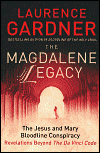
|

|

|

|
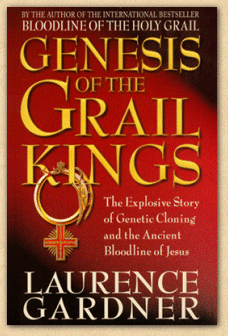 |
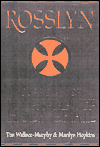 |
 |
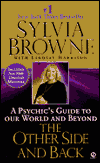 |

|
 |
 |
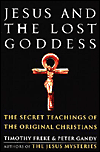 |
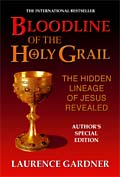 |
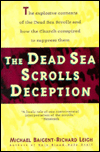 |
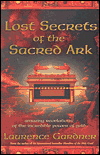 |
View My Guestbook
 Sign My Guestbook
Sign My GuestbookSearch this site
Our search Engine does not search for the links in this site, only words in the text.
![]()
We lost our previous guest book with no warning. Please sign this one.
Guestbook![]()
NO PART OF THIS SITE MAY BE COPIED OR REPRODUCED, IN WHOLE OR IN PART, WITHOUT THE EXPRESS WRITTEN PERMISSION OF THE WEBMASTER... © COPYRIGHT 1999 - 2012 C.I.C. ALL RIGHTS RESERVED.
If your site is not Strictly Masonic in nature, We
kindly ask that you do not link to this site
without permission of the Web Master or under the guidelines set forth here...
see Legal Issues
This page has been visited Times since November 31st, 1999